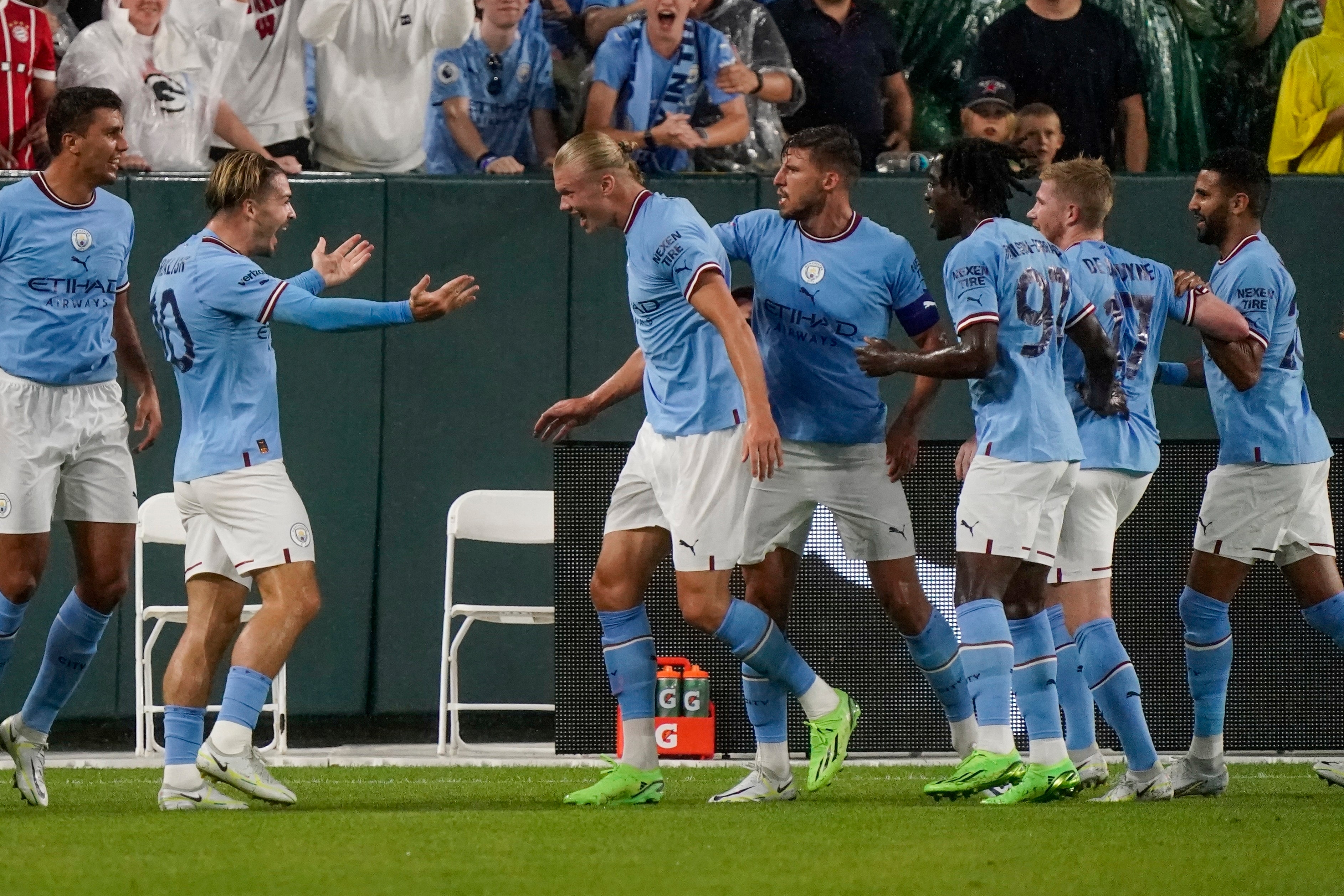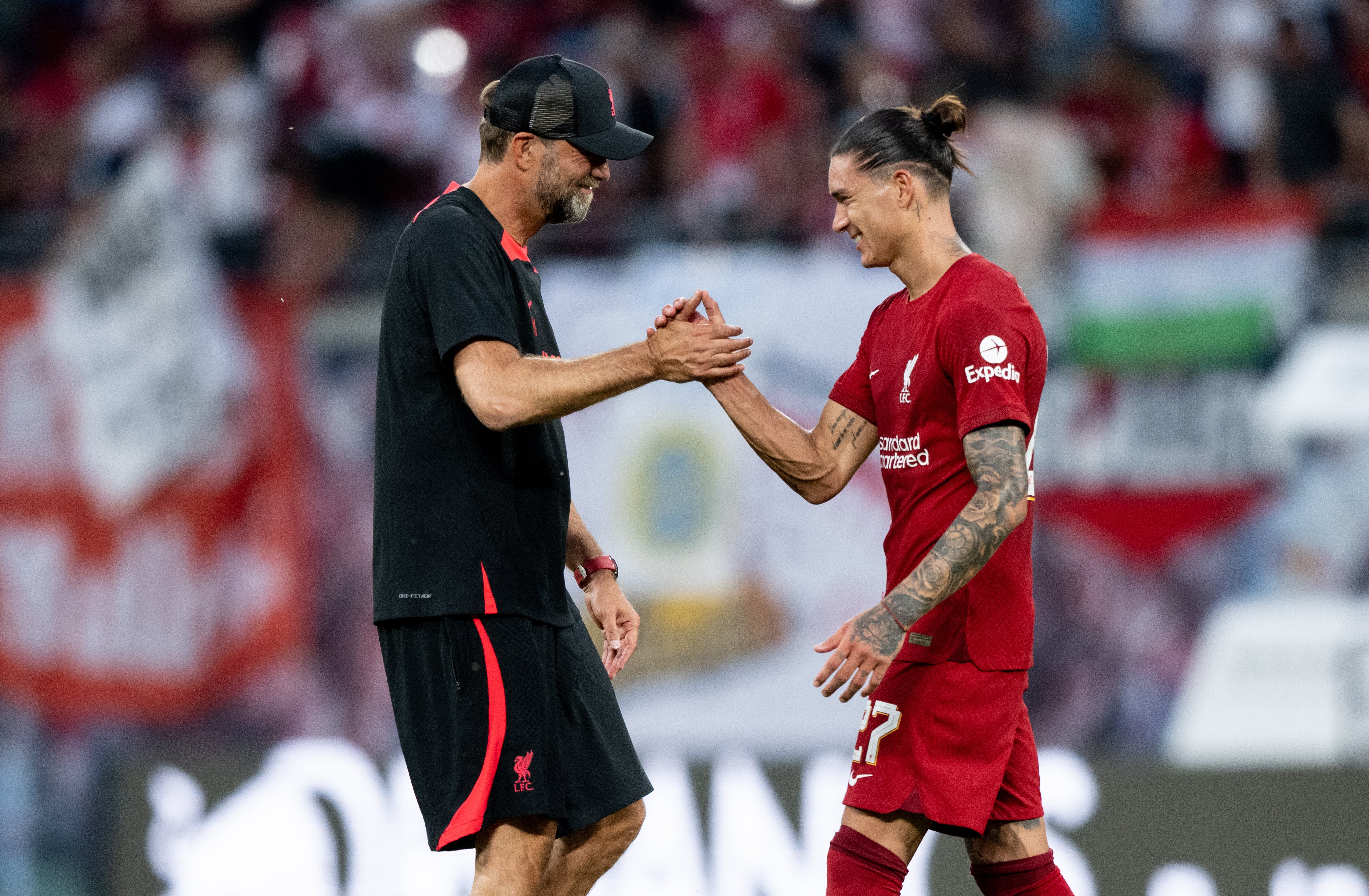Liverpool and Man City face new challenge to make old solutions work after Darwin Nunez and Erling Haaland transfers
A change in approach and goalscoring focus after the title rivals brought in classic No 9s this summer

The words came from Jurgen Klopp’s mouth but it could have been Pep Guardiola speaking. “He’s a different striker to what we have or what we had, but he’s a really good one,” said the Liverpool manager. He was talking about Darwin Nunez, while Guardiola may spend much of Manchester City’s season discussing Erling Haaland.
Their flagship signings are the sorts of players they neither had nor, perhaps, needed. City and Liverpool scored a combined total of 297 goals last season. Very few came from actual strikers: with Gabriel Jesus rebranding himself as a right winger, arguably none of City’s 150 did. Maybe only Divock Origi, who was responsible for six of Liverpool’s 147, qualified as a conventional centre-forward at Anfield. Diogo Jota could excel in the middle in his own fashion, Sadio Mane proved a remarkable success as a No 9 and Roberto Firmino remains Anfield’s definitive false nine. But arguably none would have met traditional descriptions of a centre-forward.
Enter strapping six-footers who can be defined by their scoring statistics. “His numbers are remarkable,” said Guardiola of Haaland: 115 goals in 116 appearances for Borussia Dortmund and RB Salzburg, with better than one a game in the Champions League. A fundamental difference between striking additions is that Nunez has only reached that level of potency for one season, yielding 34 goals for Benfica last year.
The Uruguayan is the older man but arguably less proven. He is the costlier: a £64m fee could rise to a club record £85m if add-ons are triggered, whereas Haaland had a £51m release clause at Borussia Dortmund – though Nunez’s wages are substantially lower.

Comparisons are inevitable, even if Klopp jokingly tried to deflect them last week. “One is left-footed, the other is right-footed,” he said. “One is from Norway, the other one is from Uruguay; they are big differences.” Nevertheless, if there is a temptation to bill both the Community Shield and the campaign as a whole as a straight shootout between them, there are reasons to think it is not quite as simple as that.
And not merely because the three seasons Mohamed Salah won or shared the Golden Boot were all years City won the title; Guardiola’s model of sharing the goals around has showed there is an alternative formula. At both clubs, there is the question if the attempt to make them better, to add another dimension, instead costs them some of the chemistry that has made them so compelling.
If Haaland becomes the penalty-box presence City have largely lacked since Sergio Aguero’s body began to betray him, they will have one fewer diminutive technician to interchange positions in intoxicating manner. At Anfield, a formation was constructed around Firmino, whose willingness to forage in midfield allowed Klopp to use narrow, goalscoring wingers. While Nunez’s Benfica goals showed a fondness for making Mane-like bursts in the inside-left channel, the inverted forward line may be no more.
For each manager, the challenge is to integrate and accommodate the expensive arrival, to tinker with the blueprint without removing too many of its existing advantages.
In their different ways, Guardiola and Klopp have been the two greatest scourges of the striker in Premier League history. The false nine felt more of an ideological preference for the Catalan and a tactical solution for the German but they both made it work stunningly well.

In Klopp’s case, it seemed more about one player – Firmino – whereas Guardiola had a rotating cast of false nines. A curiosity is that both have worked productively with the outstanding genuine No 9 of the last decade, in Robert Lewandowski. Haaland may be the finest of the next 10 years, though he could be burdened with different comparisons: with City’s record scorer Aguero and the target man Guardiola soon discarded at Barcelona, in Zlatan Ibrahimovic.
Now he has suggested City will alter their style of play to suit an aerial presence in the box. “He has to adapt to our play and of course we are going to adapt,” the City manager said last week. “With his movements and quality in the box we are going to try to put as much balls as possible in the box.” Haaland marked his unveiling by saying he hoped City’s best crosser, Kevin de Bruyne, will get more assists this season. The Belgian was the top scorer last season, customising his game to compensate for the lack of a specialist finisher.
It is notable, too, that Guardiola sold the winger who doubled up as a poacher, in Raheem Sterling. Those duties can revert to a striker now. Perhaps the dynamic will change at Liverpool, too: Luis Diaz excelled without scoring many goals last season and, whereas their top scorers in recent seasons have tended to be the two wingers, now it may be the striker and Salah.
At each, a recalibration may have begun. Nunez scored four times in a pre-season cameo against Leipzig, albeit after a glaring miss on debut against Manchester United. Haaland marked his unofficial City bow with a winner against Bayern Munich. They were predatory strikes. They are early indications the newcomers promise goals, even if it remains to be seen if there is a trade-off in what teams based around the collective lose in other areas.
But perhaps there is a cyclical element to it. In their idiosyncratic ways, Guardiola and Klopp reinvented football by removing the centre-forward. Now, by restoring a staple of sides for decades, they may have tied their fortunes this season to new players and a very old idea.
Liverpool vs Man City, FA Community Shield, kicks off at 5pm on Saturday; live on ITV






Join our commenting forum
Join thought-provoking conversations, follow other Independent readers and see their replies
Comments